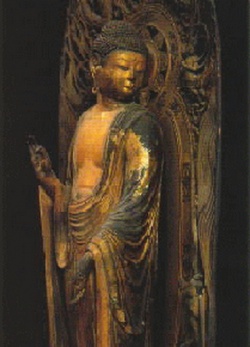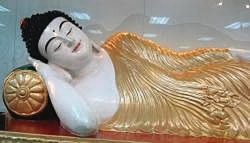Mahavibhasa
The Abhidharma Mahāvibhāṣa Śāstra is an ancient Buddhist text. It is thought to have been authored around 150 CE.
The Compendia
Vibhāṣā is a term meaning 'compendium', 'treatise' or simply 'explanation', derived from vi + √bhaṣ, 'to speak' or 'to explain'.
Evidence strongly indicates that there were originally many different Vibhāṣa texts, mainly commenting on the Jñānaprasthāna, but also commenting on other Abhidharma texts too.
The relationship between all these texts is very complex, as there is mutual influence, and the texts underwent some development from initial inception to completion.
The Taisho has three, however, which are compendiums on the Jñānaprasthāna, and its six legs: the Abhidharma Mahāvibhāṣā Śāstra (T1545), the Abhidharma Vibhāṣā Śāstra (T1546) and the Vibhāṣā Śāstra (T1547).
Of these three, the Abhidharma Mahāvibhāṣa Śāstra is considered prominent.
Its authorship is traditionally attributed to five hundred arhats, some 600 years after the parinirvāṇa of the Buddha. Its compilation, however, is attributed to a certain Katyāyāniputra.
This date and authorship is based on the Chinese translation, also of Xuanzang, and also other historical considerations.
It appears in the Taisho in its own volume, due to its huge size: T27, No. 1545, 阿毘達磨大毘婆沙論, 五百大阿羅漢等造, 三藏法師玄奘奉 詔譯, in a massive 200 fasc. which is larger than the previous Abhidharma texts combined,
and a third of the total Abhidharma literature! The Vibhāṣa Śāstra is an older translation, translated by Buddhavarman and Daotai: T28, No. 1546, 阿毘達磨毘婆沙論, 迦旃延子造, 五百羅漢釋, 北涼天竺沙門浮陀跋摩共道泰等譯.
Contents
As such an immense text, it contains a huge array of material. This includes the discussion of basically every doctrinal issue of the day, as presented by not only non-Sarvāstivāda views,
such as the Vaibhajyavāda, Pudgalavāda, Mahāsāṃghika, and others; but also non-Buddhist systems, such as the Samkhya, the Vaisheshika, and others; and finally of the Sarvāstivāda itself, as represented by its various learned and venerable leaders.
With regards the former two, their 'unorthodox' and 'incorrect' doctrines are taken to task from the perspective of the Buddhist Sarvāstivāda.
With regards the latter, several views are often expressed as more detailed descriptions of Sarvāstivāda doctrines.
These are often open ended, with no particular explanation favored over another, though sometimes a particular explanation is extolled as being particularly clear and in harmony with the teachings.
Due to both of the above reasons, the Vibhāṣa literature is particularly useful in not only understanding this school, but in also getting a good perspective on the general state of the Buddha Dharma, and other non-Buddhist religions at the time.
Sarvāstivāda of Kāśmīra
The Sarvāstivāda of Kāśmīra held the Mahāvibhāṣā as authoritative, and thus were given the moniker of being Vaibhāṣikas – 'those [upholders] of the Vibhāṣa'.
Some scholars feel that some of the Vibhāṣa texts that are now lost, possibly represented a similar authoritative text as held by the Gandhāra Sarvāstivāda, or other centers of orthodoxy.
It was due to the predominance of this text and its teachings at the time, that Vasubandhu engaged in the study thereof, as a compendium that encompassed all the essential teachings.
And Mahāyāna history
The Mahāvibhāṣā contains a great deal of doctrinal material with a strong affinity to Mahāyāna doctrines.
According to Karl Potter, the information in the Mahāvibhāṣā concerning the Mahāyāna is of considerable importance.
The text is known to employ the outlook of Buddhist practice as consisting of the Three Vehicles: Śrāvakayāna, Pratyekabuddhayāna, and Bodhisattvayāna.
It also describes accommodations reached between the Hīnayāna and Mahāyāna traditions, as well as the means by which Mahāyāna doctrines would become accepted.
The Mahāvibhāṣā defines the Mahāyāna teachings, which are described as Vaipulya (Ch. 方廣), a commonly used synonym for the Mahāyāna teachings:.
What is the Vaipulya? It is said to be all the sūtras corresponding to elaborations on the meanings of the exceedingly profound dharmas.
According to a number of scholars, Mahāyāna Buddhism flourished during the time of the Kuṣāṇa Empire, and this is illustrated in the form of Mahāyāna influence on the Mahāvibhāṣā.
The Mañjuśrīmūlakalpa also records that Kaniṣka presided over the establishment of Prajñāpāramitā doctrines in the northwest of India.
According to Paul Williams, the similarly massive Mahāprajñāpāramitā Śāstra also has a clear association with the Vaibhāṣika Sarvāstivādins.
References to Bodhisattvayāna and the practice of the Six Pāramitās are commonly found in Sarvāstivāda works.
The Sarvāstivādins did not hold that it was impossible, or even impractical to strive to become a fully enlightened buddha (Skt.samyaksaṃbuddha), and therefore they admitted the path of a bodhisattva as a valid one.


